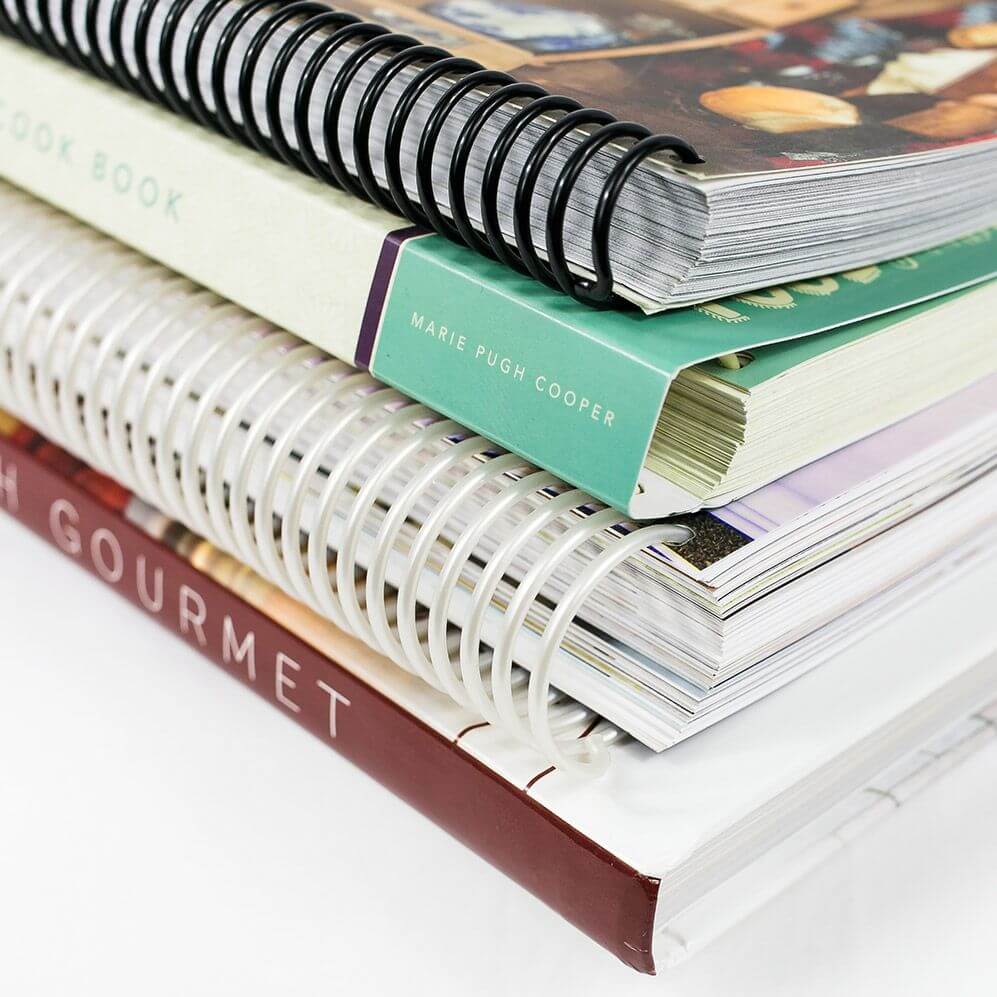There are several methods to bind your next book, each with its own benefits, uses and options to achieve the look you want.
Here are some common options:
1. Perfect Binding
- Description: Pages are glued together at the spine with a strong, flexible thermal glue.
- Pros: Professional appearance, widely used for paperbacks, cost-effective for larger print runs.
- Cons: Less durable than other methods, may not lay flat when open.
2. Saddle Stitching
- Description: Pages are folded and stapled together through the fold line (the spine).
- Pros: Economical, good for smaller booklets or magazines, lays flat when open.
- Cons: Limited to fewer pages (usually up to 64 pages), less professional for thicker books.
3. Spiral Binding (Coil Binding)
- Description: Pages are punched and bound together with a plastic or metal coil.
- Pros: Allows the book to lay flat and even fold back on itself, durable.
- Cons: Not as professional-looking for formal publications, the coil can be bulky.
4. Wire-O Binding
- Description: Similar to spiral binding but uses a double loop wire instead of a coil.
- Pros: Professional appearance, lays flat, more durable than spiral binding.
- Cons: More expensive than spiral binding, the wire can be bent or damaged.
5. Hardcover Binding (Case Binding)
- Description: Pages are sewn or glued together and then attached to a rigid cover.
- Pros: Very durable, professional, high-quality appearance, suitable for long-term use.
- Cons: More expensive, longer production time, not as flexible as other bindings.
6. Comb Binding
- Description: Pages are punched and bound together using a plastic comb.
- Pros: Economical, allows the book to lay flat, easy to add or remove pages.
- Cons: Less durable, less professional-looking, the comb can break.
7. Velo Binding
- Description: Pages are punched and bound together with a plastic strip that goes through the holes and is secured with heat.
- Pros: Secure, good for thick documents, professional appearance.
- Cons: Less flexible, not easily adjustable, requires special equipment for binding.
8. Thermal Binding
- Description: Pages are glued together at the spine using a thermal adhesive strip.
- Pros: Professional appearance, no visible staples or coils, can bind thicker books.
- Cons: Less durable than some other methods, may not lay flat.
9. Sewn Binding (Section Sewn)
- Description: Pages are sewn together in sections and then glued into a cover.
- Pros: Very durable, allows the book to lay flat, high-quality appearance.
- Cons: More expensive, longer production time.
Each binding method has its unique advantages and is suitable for different types of publications. For your e-book, considering the professional and durable appearance, Perfect Binding or Hardcover Binding might be the most suitable choices if you decide to print physical copies.
EPM Print Group, as a long term, local Queensland business and market leading print solutions agency, can assist with brand management and growth right across Australia. With our own online management portal, you can take charge of all your printing needs from the comfort of your desk or mobile phone. If your business would like to be supported by a professional, reliable, cost effective business solution, reach out to our team at sales@epmprint.com.au


No comments yet.